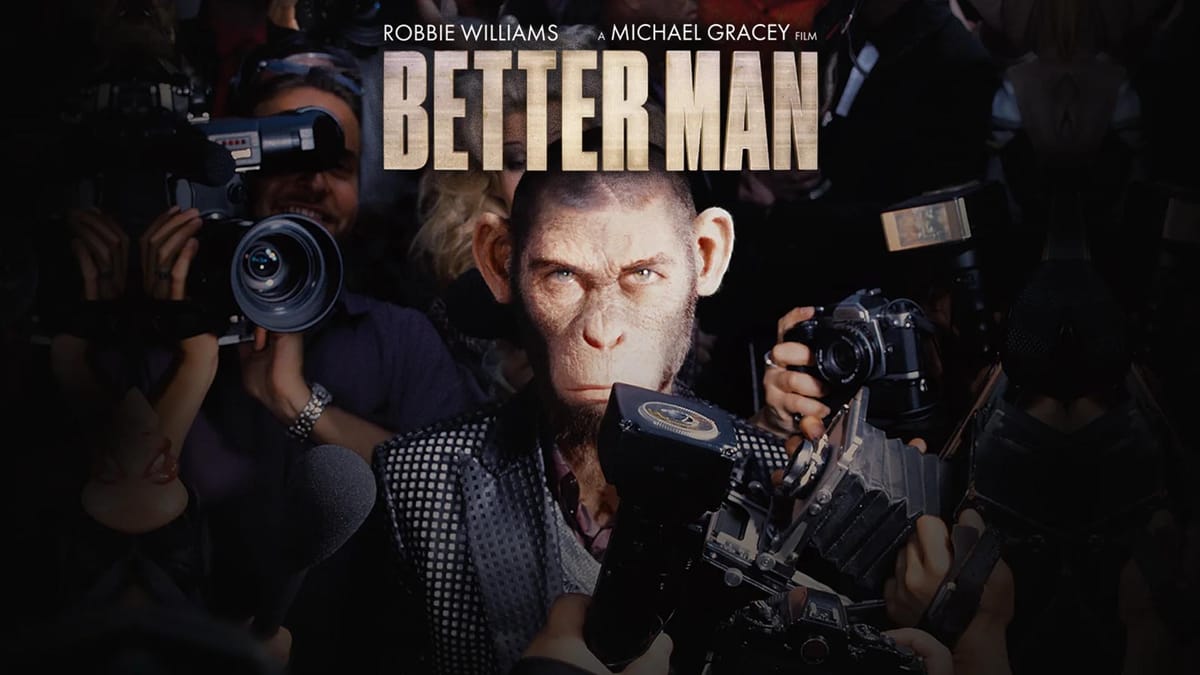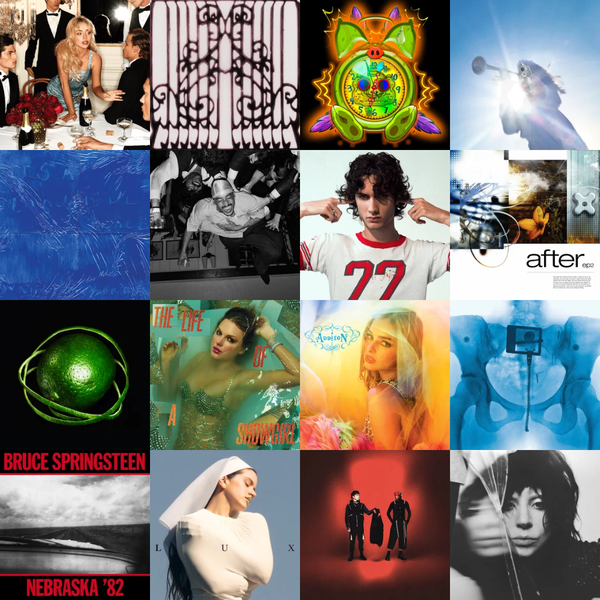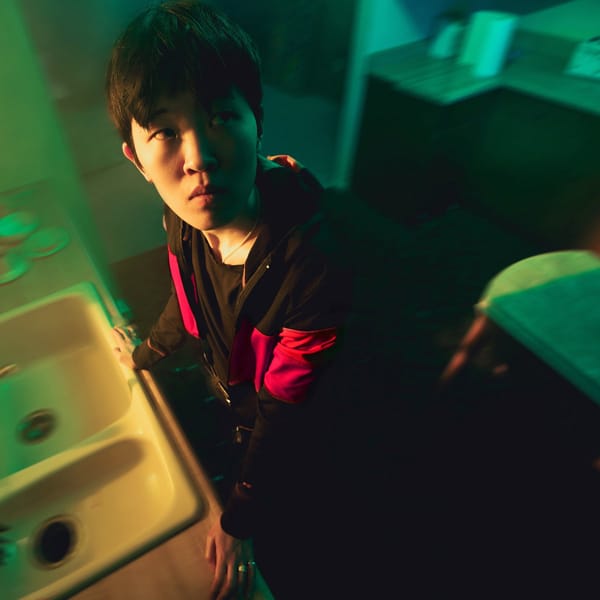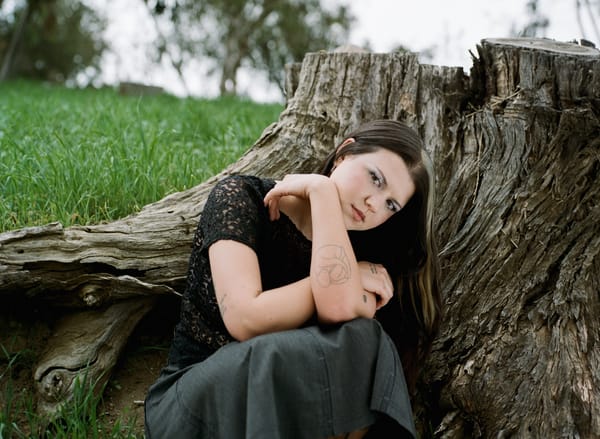Hannah Rambles About Better Man
Yes, he has to be a monkey.

Look, I needed a break from catastrophizing and working on 3848683839 other things (I counted), so here’s an overly long review of a movie I can’t stop thinking about, cobbled together from notes from my two watches. I’ve had a tough time over the past month along with every other trans person in America, and looking up stuff about this movie became my #1 distraction from the horrors. Nothing Deep To Say is coming back Friday, where I interview Will Wiesenfeld about his incredible new album as Baths.
The thing you probably know about Better Man is that it’s an $110 million biopic depicting UK pop star Robbie Williams as a CGI anthropomorphic monkey. You were probably utterly confused. Then you probably saw your friends raving about it, or you saw Taylor Tomlinson and video essayist Patrick H Willems dedicating minutes to rambling about it. You probably noticed it turns everyone who watches it into Robbie-loving maniacs, and even people lukewarm on the movie sit on it until the monkey brainworms get them too. You probably wondered how it got greenlit in the first place then you found out that it was an international co-production funded partially by the Australian government, and even more questions kept coming. You finally watched the "Rock DJ“ scene and the brainworms got you as well. Probably.
In case you don’t know who Williams is, and you’d be forgiven if you're American, the best comparison is Justin Timberlake, if Timberlake was also Michael Bublé. I’d also describe him as the UK’s 90s-00s answer to 80s Billy Joel — not the singer-songwriter era, but the pivot he made post-An Innocent Man indebted to both modern styles of that era and old-fashioned showmanship.* Williams does have some more mature, introspective songs like “Feel” and “Bodies”, it’s just rare because most of his music is either adult contemporary shlock or bubblegum pop.
What sets him apart is his charisma and sense of humor, where he simply cannot go five seconds without an innuendo or a charming self-deprecating joke. Entire NME listicles document his ‘I was in both Take That and four of the Spice Girls’ shtick, and the film’s narration indulges in that. Greatest Showman director Michael Gracey sat down to interview Williams, with no intention than to just document his life from the man himself. His story is no different than most musicians’ biopics: a rise from a working-class neighborhood to massive fame, all while he’s miserable at the top and develops severe drug addiction before he redeems himself.
Gracey noticed that Williams kept calling himself a monkey. So naturally, he decided to make a biopic where Williams is literally a full CGI primate, pushing the boundaries of character animation and causing the creation of an entire effects studio in Melbourne. Learning from the mistakes of the wildly successful but reviled Showman, he took inspiration from Terry Gilliam and Bob Fosse — whose All That Jazz I still need to see — and sought to tell the standard biopic story without holding back, especially visually. Roger Ebert insisted it’s not what a movie’s about, but how it’s about it; he would have loved Better Man.
Gracey’s background is in VFX and animation, so unlike Marvel productions where directors micromanage and “pixel-fuck” their artists, he knew exactly what he wanted. Some movies outsource VFX to several different companies to save money: Better Man sent almost all of it to Avatar and Planet of the Apes team Weta Digital. Some effects-heavy movies avoid lens flares: cinematographer Erik Wilson went out of his way to include them. Before watching, you may wonder why Better Man cost $110 million. After watching, you may wonder why Better Man only cost $110 million because the scale is so massive. A friend posited that the budget was so high because “everyone who knew what it really was realized it must be made at any cost.” It’s rare for studios to invest in a vision likely knowing they won’t see a return on investment, no matter how much of the bill they footed. It’s done for long-term gain, not short-term profit. Ultimately, it’s still a music biopic, just one that’s completely uncompromising and groundbreaking in its ostentatious presentation.
Gracey explained in an interview that when designing CGI Monkey Robbie Williams (I’ll call him CGIMRW to differentiate him from the real guy, as the movie version is portrayed by Jonno Davies**), they went back and forth between making him more apelike and making him more human, and they erred on the side of human every time. The result is natural enough that I realized I didn’t mention the actors at all while reading this back, i just thought of the characters. Gracey and co prioritize emotional truth over objective truth, and that’s why the movie works while feeling like it shouldn’t. On a rewatch, the animal is integral to the movie instead of an afterthought: one of the first songs CGIMRW sings diegetically is 1940s standard “Straighten Up and Fly Right”, a parable about a monkey outsmarting a murderous buzzard. CGIMRW is also referred to as an animal multiple times, and mentions he feels unevolved toward the end. He only shows his apelike side when desperate, crawling on all fours or bearing his fangs in anguish. Those choices make the gimmick more emotionally effective than a normal biopic usually manages.
Incredibly, the CGI never derails the heavier scenes, and if anything the magical realist flourishes accentuate the emotion. I’ve heard it theorized movie musicals rarely work because they stretch the audience’s suspension of disbelief. This one succeeds because it doesn’t even try to be realistic or grounded: We never get a time card, we rarely get so much as an establishing shot, and the songs aren’t even in chronological order. Better Man is unstuck in time, genuinely dreamlike in its construction — not ‘omg what a fever dream, were they on drugs when they made this 🤪’ but existing in a heightened reality.
The musical sequences are the highlights, but I’ll only talk about a handful here because the surprises delighted me in the theater. “She’s The One” brilliantly intercuts the highs and lows of CGIMRW and Nicole Appleton’s (Raechelle Banno) relationship with the night they first fell in love, almost like the aliens from Arrival took over the edit. “Come Undone” starts off conventional, then vividly depicts CGIMRW’s helplessness without actually getting graphic. The viral “Rock DJ” scene is the most conventional, least indicative of CGIMRW’ interiority, and requires the least context to love, so it’s no surprise that’s caught on. The scene famously took months to plan, and was almost cut due to the Queen of England’s death… just one more thing that sounds insane out of context, I guess. In the outdoors segments, there’s no soundstage, no greenscreen, no subbing in locations. For some reason, it absolutely needed to be on Regent Street, in one take, with pogo sticks and a drumline breakdown. (Apparently, it especially needed the dancing on CGI gumballs, a longtime bugbear of Gracey’s since it was rejected for his unmade Chitty Chitty Bang Bang remake.) The real highlight is when Williams performs at the 125,000-capacity Knebworth, where the film takes “fighting your demons” incredibly literally. That’s all I’m going to say about that bit, you just have to see it for yourself.***
Take away the monkey and musical sequences, and there’s not much separating it from more conventional biopics like Bohemian Rhapsody or the classic biopic parody Walk Hard. In its more formulaic passages, you would be forgiven for expecting CGIMRW to pull out some sinks when angry. It’s just hard to be a sincere music biopic and not do some of those tropes, so at least the movie handles the low parts gracefully unlike BoRhap’s often clumsy screenplay - there’s nothing like “I’ve got it.” “Got what?” “AIDS.” The movie especially handles CGIMRW’s fraught relationship with Appelton of All Saints well, including a handful of particularly uncomfortable scenes late in the film.
Even the things that don’t work in Gracey’s smart but occasionally conventional script (co-written with Simon Gleeson and Oliver Cole) feel deliberate on a rewatch. I will say it does get a little too self-pitying when every person in CGIMRW's life tells him to get his act together, though that's easy to overlook. When the movie starts to run in place, it's never long before the next wild creative choice. Some think the redemption arc for CGIMRW’s arrogant, grifting father (Steve Pemberton) is unearned, but remember who’s telling the story. He’s a showman, and he’s also someone who needs closure. He didn’t perform “My Way” with his dad in real life, but he ends it this way because it feels like Williams – or his equivalent – needs it to. Interpreted as just another fantasy sequence, it’s more satisfying.
CGIMRW/Robbie Williams’ eventual self-acceptance as a vapid cabaret performer is in some respects an admission of defeat, that maybe his dad was right about performing for others to forget about their problems. Most jokes about the film are that Williams has no song where he needs to be as intense as he is in the Knebworth performance, but 1. The film is so aware of this even Gracey bragged Rock DJ has a real bassline now 2. maybe they did need to do all that for the Australian economy and the future of VFX. If the Avatar movies have furry little blue monkeys in the future, you know who to thank.
Maybe Williams’ darker side was ahead of its time. People do want to hear about other people’s problems now, especially now that music is less communal and more insular, it’s just not Williams’ strong suit. He has nothing deep to say (lol) in his music, and he accepts that when the final song in the film is a cover; to quote his US equivalent, he is the entertainer, and he knows just where he stands. Every other review closed with the “let him entertain you” joke, and yeah, I will too. In my defense, how else am I supposed to end a review of a movie that indulges in cliché but makes it all work?
If enough people subscribe to the paid tier from this issue, I'll rank every musical number from the movie.
*I also considered “who Seth McFarlane wishes he was”
** Just so we’re clear: Jonno Davies plays Robbie in the mocap suit, and Williams voices him (though there are possibly some machine learning shenanigans involved with blending Davies and William’s voices, which is fine by me if done with the consent of everyone involved). Vocalist Adam Tucker sings the music with Robbie, their voices blending together as well. For anyone that knows who Drew Seely is, that’s nothing new in movie musicals.
**** Unfortunately, the sound mix on the home release doesn’t do this scene justice, but in the theater it was one of those ‘levitating-out-of-my-seat‘ moments that are the reasons I go to movies.


